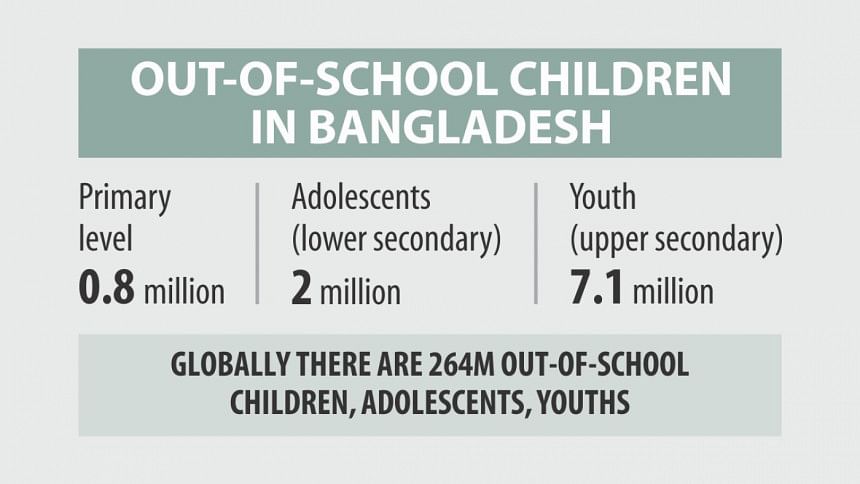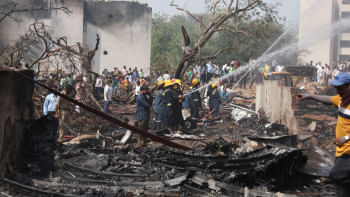Education a mirage for them

There are about 10 million out-of-school children, adolescents and youths in Bangladesh, says a new Unesco policy paper.
The country has the fifth highest number of out-of-school adolescents and the third largest number of out-of-school youths in the world.
The total number of out-of-school children (6-11), adolescents (12-14) and youths (15-17) across the globe is nearly 264 million, says the paper, titled “Reducing global poverty through universal primary and secondary education”.
It was released last week ahead of the UN High Level Political Forum starting on July 10 in New York. The forum would focus on poverty eradication in pursuit of the 2030 Sustainable Development Goals (SDGs).
The out-of-school population includes children who were in school but have since dropped out, who were never in school but are expected to enter at a later period and also those who were never in school and are not expected to enroll ever.
The global primary out-of-school rate has remained static for eight years in a row, said the paper, adding that global poverty could be more than halved almost within a generation if all adults completed secondary school.
Data compiled by the Unesco Institute for Statistics (UIS) shows that Bangladesh has 7.1 million out-of-school youths, the third highest in the world after India (46.8 million) and Pakistan (9.8 million).
There are two million out-of-school adolescents in Bangladesh, fifth highest in the world with India (11.1m), Pakistan (5.4m), Ethiopia (4.6m) and Indonesia (2.2m) topping the first four slots in the category.
With 0.8 million children (primary age-level) out-of-school in the country, Bangladesh fared comparatively better in this category compared to higher numbers in the adolescent and youth categories.
According to the draft of Bangladesh Education Statistics 2016, over 2.87 crore students are currently studying in primary and secondary schools. Last year, the net enrolment rate at primary level stood at 97.96 percent and 73.10 at secondary level.
The Unesco paper says six countries are home to more than one-third of all out-of-school children of primary age. They are Ethiopia, India, Indonesia, Nigeria, Pakistan and Sudan. Globally, there are 61 million children of primary school age who are out-of-school right now.
It says: "Far too many children, adolescents and youth are still out-of-school for multiple reasons relating to their living conditions, financial constraints and social adversities.”
While it is very challenging to bring out-of-school youth back to education, there is also a worrying slowdown in the pace at which the world's children and adolescents are being integrated into national education systems, it said.
The global number of total out-of-school population has dropped from over 374 million in 2000 to 264 million now, the Unesco report notes, adding that the out-of-school rate has not budged since 2008 at the primary level, since 2012 at the lower secondary level and since 2013 at the upper secondary level.
Unesco's Global Education Monitoring (GEM) report shows that nearly 60 million people could escape poverty if all adults had just two more years of schooling. If all adults completed secondary education, 420 million people could be lifted out of poverty, reducing the total number of poor people by more than half globally and by almost two-thirds in South Asia and sub-Saharan Africa, says the paper.
Studies have shown that education has direct and indirect impacts on both economic growth and poverty. Education provides skills that boost employment opportunities and income while helping to protect people from socio-economic vulnerabilities. A more equitable expansion of education is likely to reduce inequality, lifting the poorest from the bottom of the ladder, said the report.
Despite education's potential, new UIS data shows that there has been virtually no progress in reducing out-of-school rates in recent years, according to the report.
Globally, nine percent of all children of primary school age are still denied their right to education, with rates reaching 16 percent and 37 percent for youth of lower and upper secondary ages, respectively.
Sub-Saharan Africa remains the region with the highest out-of-school rates for all age groups. Of the 61 million children of primary school age currently out of school, 17 million will never set foot in a classroom if current trends continue, it said.
Girls in poor countries continue to face particularly steep barriers to education. According to UIS data, in low-income countries, more than 11 million girls of primary age are out of school, compared to almost 9 million boys. The good news is that the girls who do manage to start school tend to complete the primary cycle and pursue their studies at the secondary level, added the Unesco paper.


 For all latest news, follow The Daily Star's Google News channel.
For all latest news, follow The Daily Star's Google News channel. 








Comments